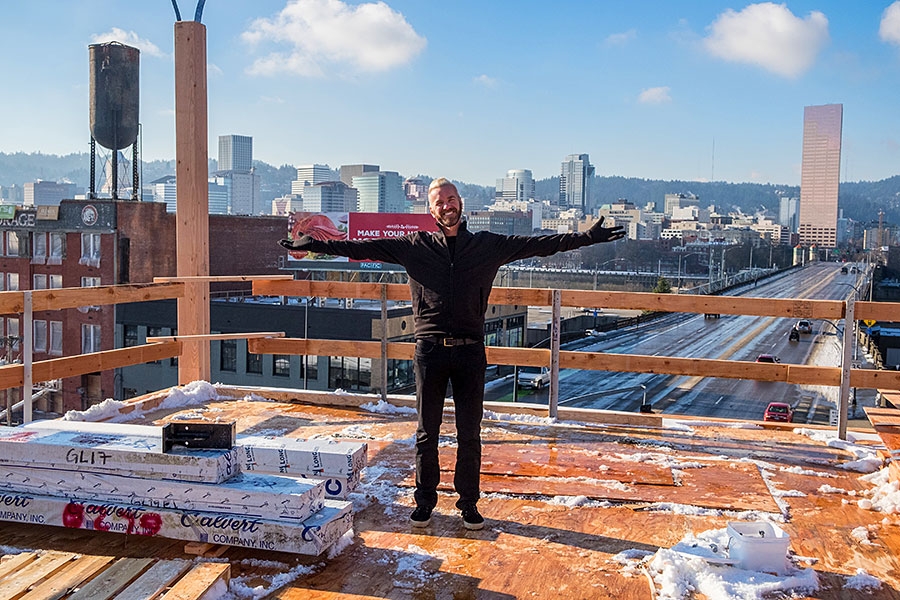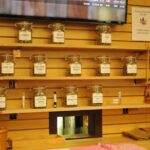Kevin Cavenaugh develops eye-catching projects funded by innovative financing tools. But will his art-infused buildings revitalize or gentrify the city?
It’s a sunny morning in December, and Kevin Cavenaugh is standing on the top floor of his latest creation, the Fair-Haired Dumbbell.
Though situated on a small city-owned traffic island created by the Burnside-Couch couplet (hence the “fair-haired” phrase, a play on “redheaded stepchild”), it will nevertheless be the most prominent and bold building yet in this architect-trained developer’s career. Two six-story office buildings connected by a bridge — the “dumbbell” — will be wrapped in a whimsical, wildly colorful, artist-painted façade, with irregularly placed windows scattered from foot to eye level.
Dressed in black, a self-described sartorial symbol of mourning after Donald Trump’s election, Cavenaugh is feeling confessional about the reception likely to greet this oddball building once it’s completed.
“People are going to hate it. Hate it,” he says almost gleefully, even offering that his wife asked him not to go through with the project for fear its bold look would be controversial.
Yet Cavenaugh, 49, is inherently an optimist. His black outfit is topped with a dyed-blond haircut shaved at the sides, like a cross between a peacock and the rock musician he used to be during his college days at U.C. Berkeley. And besides, he says about the Dumbbell, “some people are also going to love it.”
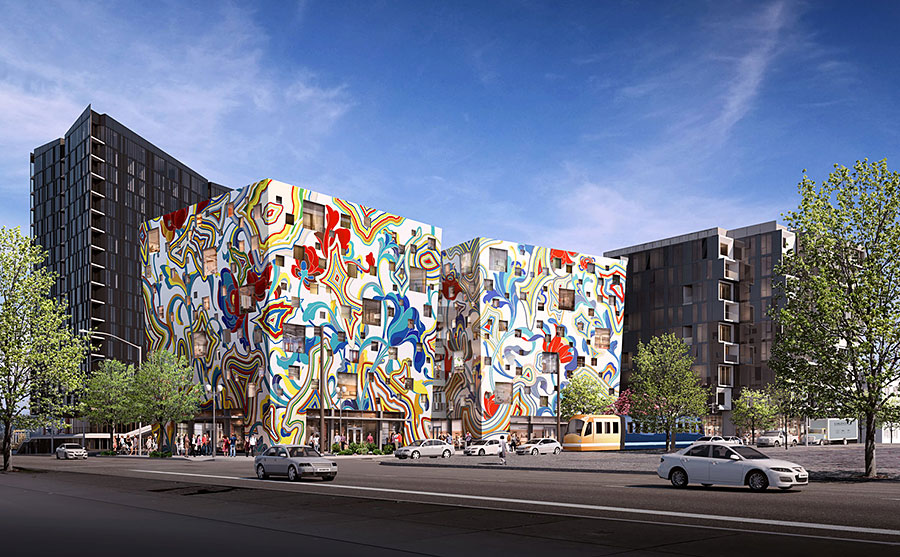 A rendering of the Fair-Haired Dumbbell
A rendering of the Fair-Haired Dumbbell
Cavenaugh, who founded and leads Portland’s Guerilla Development, would rather people hated the building than find it boring — the kind of bland, cookie-cutter architecture that is shaped only by a desire to maximize profits.
To be sure: Cavenaugh is not the only local developer who favors uniquely designed spaces populated by local businesses. Developer Tom Cody of Project has a similar recipe for success, for example, as does the trio behind Urban Development + Partners. But perhaps more than most in his profession, Cavenaugh takes pride in making his buildings artful and funky. Each project is a labor of love, one this former Harvard Loeb Fellow not only develops but essentially co-designs.
“I want to live in a city where people are OK with 20% instead of 22 and a half,” says Cavenaugh. He’s referring, specifically, to the rate of return he received on one of his projects, a micro restaurant complex in Northeast Portland called the Zipper.
The building’s exterior façade features a series of fins painted with imagery that, when viewed from a moving vehicle, appears to 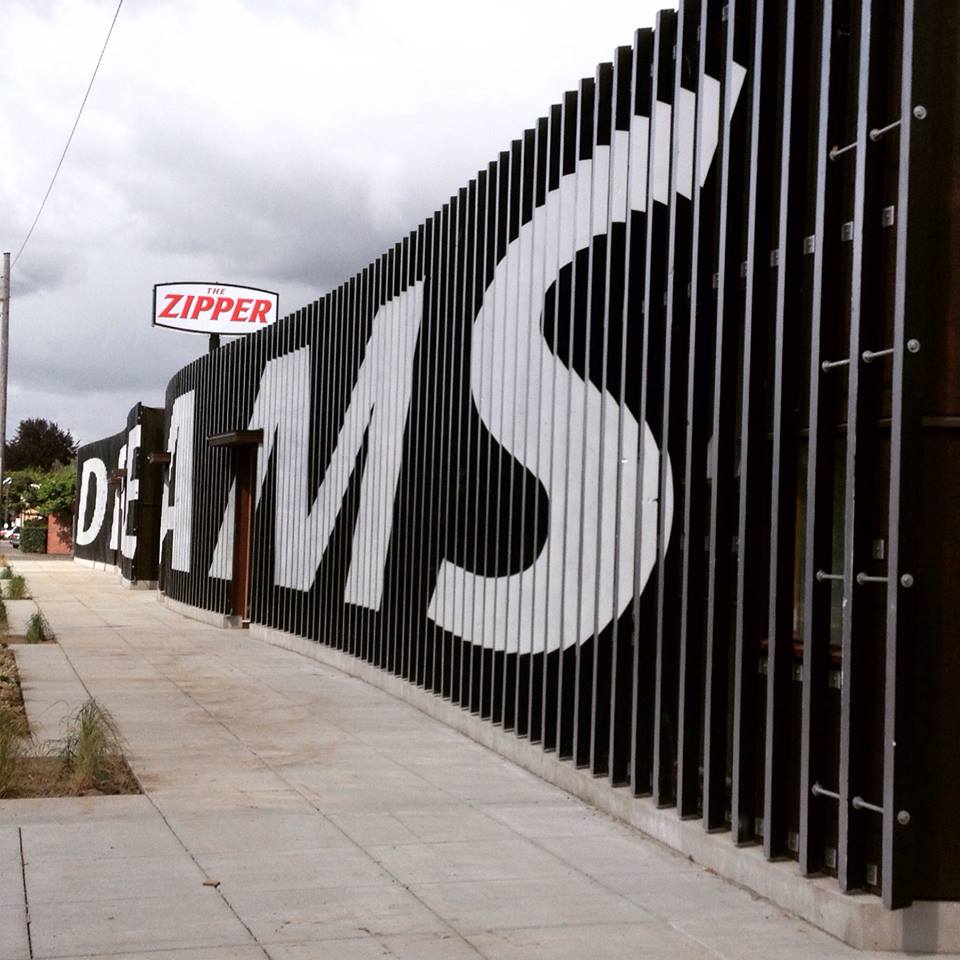 move like a cartoon in a flipbook. If Guerilla Development hadn’t invested in its eye-catching lenticular façade art, the rate of return would be a little over 22%, Cavenaugh says.
move like a cartoon in a flipbook. If Guerilla Development hadn’t invested in its eye-catching lenticular façade art, the rate of return would be a little over 22%, Cavenaugh says.
“I want to live in a city where that artwork matters,” he says.
It’s the kind of attitude that goes over well in a city beset by a rental crisis that is putting many artists on the streets. But it also puts Cavenaugh in a bind. He has spent well over a decade creating artist and creative class-friendly buildings in up-and-coming areas, but in so doing, it’s arguable that he helps those areas gentrify and become prohibitively expensive for the very demographic he hopes to attract.
Often putting creative design over profits, Cavenaugh has not been left untouched by the boom-and-bust cycles of real estate, nearly going bankrupt five years ago in the aftermath of the Great Recession. But he’s a creative thinker, innovating new means of crowdfunding projects and seeking to solve Portland’s affordable housing crisis without subsidy. And he’s optimistic about the city’s future.
“I know that Portland has more good developers than most cities, and that’s good for the city,” he says. “We’ll be fine. In fact, I believe we’ll be better than fine.”
***
Born and raised in suburban Fremont, Calif. between Oakland and San Jose, Cavenaugh came to Oregon in 1993 after studying architecture at U.C. Berkeley and completing a two-year Peace Corps stint in Gabon, where he built houses and schools. In Portland Cavenaugh initially fixed up old houses, but his real breakthrough into development came at his next job, at FFA Architecture and Interiors.
“He was always very enthusiastic, and it seemed as though he was on a different course than some of our other architectural interns,” remembers FFA principal Troy Ainsworth. In those days, Ainsworth adds with a chuckle, Cavenaugh was more clean-cut, sporting khakis and button-down shirts. But he was still different. “A lot of the younger designers are all about pure design or they’re about technology,” Ainsworth says. “But Kevin was interested in how the project gets figured out more holistically, not only design but finding the site, financing, working with people. Fairly quickly senior management started to team up with Kevin because he had ideas about developing projects.”
Cavenaugh once described combining design and development as a chance to use both the right and left sides of his brain. The projects he began constructing in the 2000s all offered not simply design whimsy but practical thinking about how to make community-gathering places. It’s not that he’s a genius, but he is someone who thinks local and, the whimsically colorful nature of his building exteriors not withstanding, conceives his projects as social spaces where people come together.
“Kevin is pretty intentional about his buildings really being part of the community,” says Lisa Abuaf, Central City manager for the Portland Development Commission. “And if you look at his projects, they’re populated with small local businesses.”
Cavenaugh’s first two developments, 2001’s Ode to Rose’s building and 2002’s Box + One, were both located in up-and-coming Portland neighborhoods (Beaumont in Northeast and Kerns in Southeast), and anchored by popular eateries on the ground floor (Fife, Noble Rot Wine Bar and Crema Coffee + Bakery) with outdoor seating. Uncommonly at the time, Box + One’s front façade was a large glass garage door, enabling Noble Rot to spill onto the sidewalk like a Parisian café.
“We became fast friends with Kevin,” recalls Leather Storrs, chef and co-owner of Noble Rot. “He ingratiates himself with tenants in a way that’s unusual. He’ll make promises in the name of friendship that may not be in his interest as a businessman.”
When Crema Bakery’s owner wanted to sell the business a few years later, then-employee Collin Jones faced difficulty securing the financing to buy it. So Cavenaugh personally guaranteed the loan, even though he had already sold the building and had no financial interest.
“I’d never dealt with a someone like him before in terms of the relationships,” remembers Jones. “He’s very much hands-on.” Recently Cavenaugh invited Jones to open a second Crema Bakery in the Dumbbell. “I’ll bet Peet’s Coffee would guarantee more in rent than I would,” Jones says. “But that’s not what Kevin’s interested in.”
The Burnside Rocket building, constructed in 2007, was larger and more ambitious, earning a LEED Platinum rating (the highest available) for its sustainable features and winning an Urban Land Institute Global Award for Excellence. The $3.9 million structure was Cavenaugh’s first to feature a colorful, artist-painted exterior — a badge of honor displaying to the community and to potential tenants that this was a place friendly to young creatives and embodying the “Keep Portland Weird” bumper-sticker mantra.
“Kevin’s projects are distinctly personal, but he gets enough voices involved to make them practical and sustainable,” says Storrs, who moved Noble Rot to the top floor of the Rocket building. “He’s a risk taker, and that’s fun. But he does extend himself.”
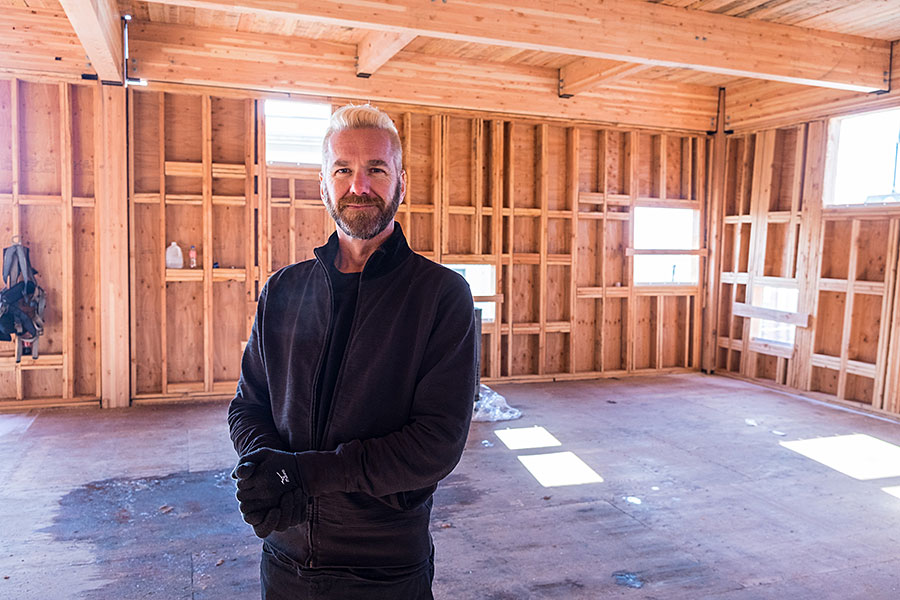
Indeed, Cavenaugh has not been without moments of crisis.
In 2012 the Burnside Rocket’s lender re-appraised the value of the building from its original $4.2 million to $2.8 million post-recession, and subsequently requested an $800,000 payment in order to re-establish the 70% loan-to-value ratio.
“Of course I didn’t have that money,” Cavenaugh says. “I didn’t have any investors. I didn’t have any horsepower.” His early projects were all financed with personal bank loans such as this. The fine print allowed the bank to sue for foreclosure, and his lawyer recommended that Cavenaugh declare bankruptcy.
“All I said to my lawyer was, ‘I don’t believe in bankruptcy and I don’t believe in foreclosure,’” he recalls. “’I’m not moving. I’m not running away. I will do whatever it takes to keep my reputation strong and stout.” Cavenaugh made payments every month and kept the building full of tenants. “But the bank, Pacific Continental, wanted this building off their books. The most aggressive thing they could do was sue me to force a sale. I sold the building. And then it all went away.”
The experience left Cavenaugh more than $1 million in debt and inspired him to be less dependent on banks. Hence the crowdfunding mechanism used to shore up the Fair-Haired Dumbbell. The way Cavenaugh talks about it, real estate crowdfunding is also possible adjunct to building affordable housing, as it allows the everyman to own real estate.
“It does its little part to allow everyday investors an eight percent return where they’d be getting one and a half percent on a CD at their local bank,” he says. About $1.5 million of the Fair-Haired Dumbbell’s $18 million budget comes from crowd-sourced fundraising, enabling modest investments of as little as $3,000.
It began as a necessity — Cavenaugh wasn’t sure he could borrow enough for the building — but once he did, he kept the micro-financing component in order to make a modest profit for his small investors.
“It doesn’t make the building more profitable. It’s slightly less profitable for me this way,” he says. “But there are a lot of schoolteachers and mechanics and librarians who own the Fair-Haired Dumbbell with me, and I think that’s such a powerful move.”
Having a group of small-scale investors means Cavenaugh feels an added sense of responsibility to make each project financially successful.
“I can’t be as cavalier now,” he says. “I need to be much more thoughtful. I only knew how to play offense before. And now I’ve learned to play offense and defense. If I don’t learn from the recession, if there aren’t deep lessons that I can take away from that, shame on me.”
The Dumbbell is not just funded differently than the Burnside Bridgehead buildings going up beside it. It’s also a defiantly different scale. At six stories, the $18 million Fair-Haired Dumbbell stands in the long shadow of two new sleek glass and steel apartment buildings, Yard and Slate. Cavenaugh’s plot of land would have allowed a taller structure, but he preferred a more human scale — and to go against the grain.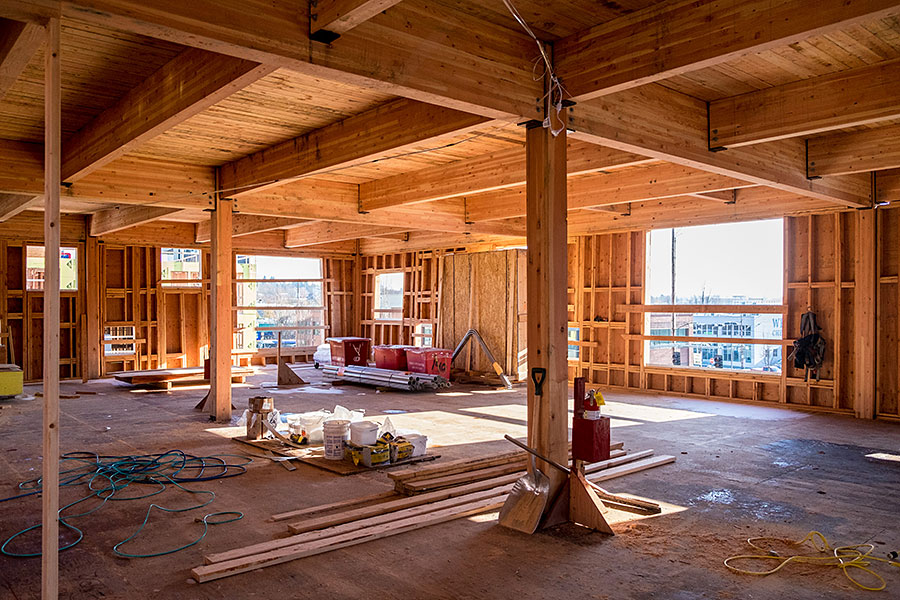 On the construction site of the Fair-Haired Dumbbell
On the construction site of the Fair-Haired Dumbbell
Cavenaugh’s buildings tend to be built in up-and-coming areas, but the Dumbbell site is more prominent. Can the eclectic look work, or will the building become best known for being disliked, like its colorful cousin of a generation ago, the Portland Building? Tad Savinar, for example — an urban designer, artist and member of the Portland Design Commission — voted against commission approval of the Dumbbell design not because of its bold colors but out of concern about what he called the “fit and finish” of the building. (The commission approved the Fair-Haired Dumbbell’s design.)
“While his other projects have located themselves in gritty or more urbanistically intimate settings, this one is front and center and will require a very crisp execution,” Savinar explains.
“Commercial real estate is usually about avoiding or minimizing the risks,” says developer Brad Malsin, whose company, Beam Development, has long been active in planning the Burnside Bridgehead. Cavenaugh embraces risks other developers eschew.
“I think Kevin was drawn to this site because it’s very challenging, on that piece of land in the middle of the couplet,” Malsin says. “How do you make something that stands out? It’s all about telling stories with real estate. I think he saw an opportunity for a really interesting story.”
Cavenaugh also wants to create and cultivate a sense of place, one that’s decidedly not corporate, and one that caters to locals. “I think Kevin is a creator of urban social spaces first and a developer second,” says Savinar. “While I am not saying that Kevin is a conceptual artist, he does work much like one. The artist is driven to communicate something specific and then sets about to investigate as to how to accomplish it.”
That said, Cavenaugh knows if he’s to be a successful developer, the projects have to make a profit. He tends to hold on to his buildings whenever possible, considering them long-term investments rather than products to sell upon completion.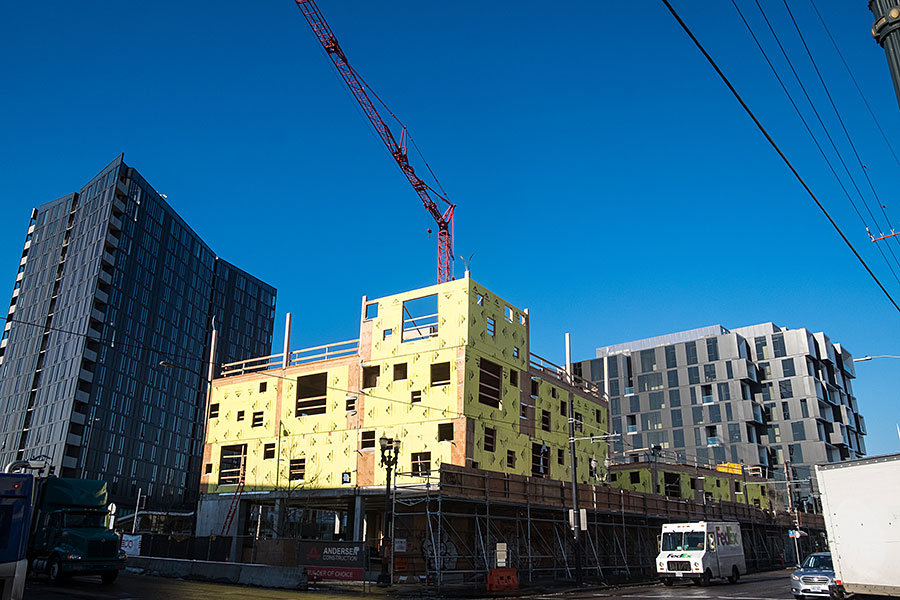 Fair-Haired Dumbbell under construction
Fair-Haired Dumbbell under construction
Unlike other developers, Cavenaugh often builds at smaller heights than what zoning allows. The Zipper on Northeast Sandy Boulevard, for example, completed in 2015 for $1.9 million at the site of the former Vic Alfanso Cadillac dealership, is single story despite an allowance of six floors — not because Cavenaugh is anti-density (he’s enthusiastically for it) but because he sees each project as an experiment. For the Zipper site, he imagined a bar surrounded by micro restaurants, a plaza with outdoor tables and a fire pit.
“I had this location where it could be loud as all hell at 2 in the morning, and I wasn’t going to be a bad neighbor,” he says. “So I ran the numbers and they worked. I didn’t run the numbers on a six-story housing building because I wasn’t inspired by that.”
And Cavenaugh believes taking 20% profit over 22 makes it more stable as a long-term hold because the artwork communicates youthful irreverence and attracts an audience.
“I never have a vacancy,” he adds. “People move out of one of my buildings and it’s filled the next day. I think on some level, or at least I hope, it’s because of the design and the artwork and the care that went into it. If I just throw up whatever, I think it’s going to sit empty for a while.”
Even as the Fair-Haired Dumbbell nears completion, graduating Cavenaugh to greater development prominence, he retains doubts about his role in the bigger picture. Given how Portland’s cost of living has skyrocketed, Cavenaugh worries about being an enabler of gentrification.
“I’m now realizing that by helping to ‘turn’ these gritty locations into more desirable addresses, I am playing an integral part in their gentrification,” he wrote in an email. “I’m now questioning whether I want to continue that or not.”
Yet the man in black ultimately can’t help but see the upside. Cavenaugh has rarely built housing in the past, but his next project is a six-story, 86-unit apartment project called the Atomic Orchard Experiment, across the street from the Zipper’s fire pits on Sandy. Cavenaugh pursued the project “because I don’t want to wait for the city to figure out the affordable-housing crisis,” he says, adding that he does support inclusionary zoning, which was recently approved by Portland City Council. “I’ll do it myself.”
Cavenaugh lives with his wife Beth (a hospice nurse) and three kids (Jack, 19, Gracy, 17 and Lilijane, 12) at Dr. Jim’s, a former Standard Dairy warehouse near Southeast Belmont Street that Guerilla Development in 2013 converted into two to four-bedroom market-rate, single-family lofts. Before that the family lived at the Ocean, which was converted from a defunct car dealership off Sandy into micro-restaurants and a loft. Cavenaugh is more fun dad than stern disciplinarian and says he asks only a few things of his kids, which could also be a personal credo: “Be kind and be happy. Chew with your mouth closed, give strong handshakes and look people in the eyes when you talk to them.”
For the Atomic Orchard, Cavenaugh also hopes to do his part to curb gentrification. He is asking investors to take a smaller rate of return in order to keep a portion of the rents low (under $600 per month, compared to comparably sized units in the same building at $1,400 monthly), thereby serving the neighborhood and ensuring that the local population isn’t pushed out by higher rents.
“It’s not impossible, but it’s not easy either,” Cavenaugh says of his latest project-cum-experiment. “I’ll figure it out though; I’m certain of that.”


